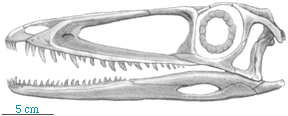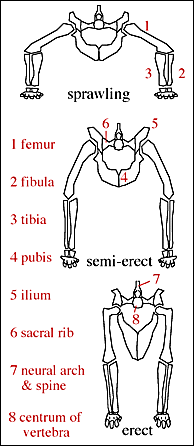
The skeleton of Coelophysis (gracile form), based on the Ghost Ranch material. After Paul (1988)
Late Triassic units younger than the Ischigualasto Formation have produced much more in the way of remains of dinosaurs. One of the two most notable forms is Coelophysis known from dozens of articulated skeletons from the Chinle Group.

| Coelophysis is a small, very delicate dinosaur characterized by a relatively long neck and an elongate skull. In contrast to Herrerasaurus, the foot is narrow with only three prominent toes. |  Skull of Coelophysis. After Paul (1988). |
Three types of posture can be identified in the Archosauriformes (seen also in the Synapsida independently).
 A sprawling gait is primitive for the Amniota and consists of having the limbs in a perpetual "push-up" position. This posture is associated with sinuous motion of the body during locomotion. In this way each limb moves through an arch largely in a plane parallel to the ground. Living lizards have this posture and can move very fast. However, the sinuous motion of the body alternately collapses the lung on each side, preventing breathing during running. That's why lizards have to stop completely and pant after they run, even though they risk capture. A sprawling posture and gait was probably typical for most non-Archosaur Archosauriformes.
A sprawling gait is primitive for the Amniota and consists of having the limbs in a perpetual "push-up" position. This posture is associated with sinuous motion of the body during locomotion. In this way each limb moves through an arch largely in a plane parallel to the ground. Living lizards have this posture and can move very fast. However, the sinuous motion of the body alternately collapses the lung on each side, preventing breathing during running. That's why lizards have to stop completely and pant after they run, even though they risk capture. A sprawling posture and gait was probably typical for most non-Archosaur Archosauriformes.
Crocodiles have a semi erect posture (sometimes called semi-improved). When moving slowly, their posture is sprawling, but when they run, their body straightens out and they pull their legs nearly under their body. When they carry their bodies more nearly erect, they are said to exhibit a "high walk". In this posture the lungs can still operate. Some crocodiles are even capable of galloping. Galloping is the fastest type of longer term quadrupedal motion in which all four feet are off the ground simultaneously during one phase of the step cycle. Most non-ornithodiran Archosauria certainly had the semi-erect posture.
The Ornithodira have an erect posture and gait (often called fully improved) in which the limbs are held directly under the body and flexed in a plane parallel to the body axis. The limbs move in this parasagittal plane during walking slowly as well as running. This allows easy breathing while running. The open acetabulum is the culmination of the permanent attainment of the erect posture.
The open acetabulum is associated with a series of logical mechanical features related to the erect posture and gait of dinosaurs. First, the femur is bent proximally, at right angles. With the femur in the parasagital plane, forces are directed ventrally to the dorsal part of the cup of the acetabulum. In the sprawling and semi-erect postures, forces are directed towards the mid-line of the body, and thus the acetabulum needs to have a bony wall to resist these medially (towards the mid-line) directed forces. In the fully erect posture, dinosaurs had no need to buttress the inside wall of the acetabulum. It could therefore be made of softer (and lighter) tissue.
Perhaps most importantly, the erect posture allows for full-time bipedalism (walking on the hind legs only), thus freeing the hands for grasping. Bipedality seems to have been another shared derived character for dinosaurs, although it was lost in some later groups.
Click the Back button to return to the lesson.